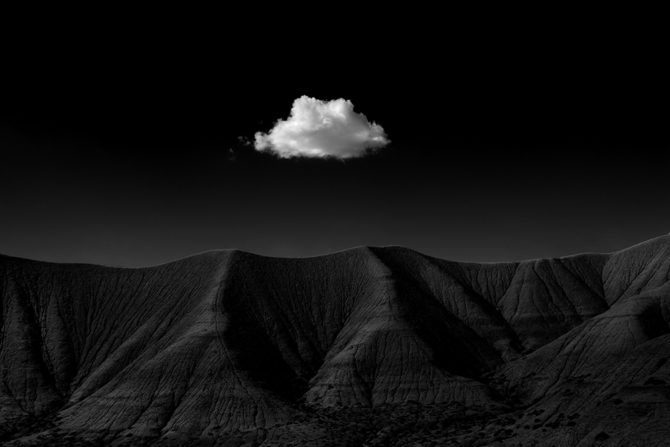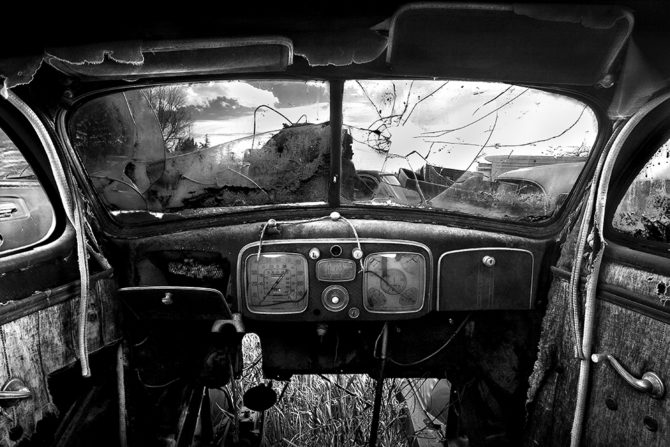April 24, 2015
Is Imitation the Sincerest Form of Flattery?
Last week someone asked if I was flattered when people copied my work. I said no, but that I wasn’t offended either.
What I actually feel is a bit of sadness. I’d rather see that person putting their energies into finding and following their Vision rather than walking where I have already walked.
Now these are friends and well-wishers who send me these imitations and so I am sincerely touched by the kind gesture. Sometimes they send a Lone Man or a Harbinger and sometimes it’s an Old Car Interior.
But honestly, I’d prefer they sent me something that they had created from their own Vision.

I very well understand imitation because I’ve copied other artists too, sometimes unconsciously and unfortunately sometimes consciously. For years I tried to copy Ansel’s work, and not just his look. Once I went to Yosemite and tried to recreate specific images of his!
I look back now and see how silly that was. Was my goal in life to be known as the world’s best Ansel Adams copycat?
Someone once wisely said to me: “Ansel’s already done Ansel and you’re not going to do him any better.” It’s true.
I know that many believe that imitation is a part of the learning process. I have many photography students contact me to say that their assignment is to copy one of my images.
I must say that I strongly disagree with this approach. I believe that their time would be much better spent finding their own Vision, and that imitation actually retards their personal Vision progress.

Colefucius says: They who walk in another’s footsteps, never finds their own path.
Is imitation is the sincerest form of flattery? I don’t think so.
Cole


Is it the fact that they took these images or that they sent them to you? I have taken many pictures in salvage yards, some similar to yours, and I took them before I ever saw one of your pictures. So it’s not imitation or flattery that I took them, but you would not know that. But if I then send you a copy, it is not imitation, perhaps flattery, but most likely it is more like a person who collects old postcards showing one to a fellow collector. They know you like them, and wanted to show you their collection, so both. Perhaps Confucius would also say, “enjoy it, and don’t worry about the why”.
Cole. We all live on the backs of giants. All the photographers before us are part of us. They give us the starting point to go beyond making just a snapshot. Yes Ansel has done it or a unknown like Vivian Maier is out there. So as photographers study a image and may reproduce it. This may be the starting point for them to go beyond and created their style.
I my field of wood art, we deal with the same issues, sometimes much worse. But that way I feel is that if I am getting paid to teach my technique, I have to expect people to do what I just showed them even if it means they did the same exact thing. The bad side is when people try to pass of what they produced as their own original work. Sometimes these people get called out for that when they post the photos online. I try to keep my work evolving so that if anyone does what I do, I am already onto something else. I am happy to teach the techniques. WIth the time it takes to do my effects, not many have put in all the hours it requires but what I have taught might give some inspiration for them to adapt part of what I do.
I’m an “advanced beginner” … so when I see an image I really like, I might try to copy it just to see what I need to do to get that effect … maybe it’s the lighting, maybe it’s the angle, maybe it’s the use of color or filters. I need a starting point because I don’t yet have a style … and I’m not sure at this point, whether I even have a vision. But I know what I like when I see it, so I need to learn how to do it myself. If that is called “imitation” then I guess I’m guilty. But, really … if I see a photo of a red rose that has a gorgeous bokeh and want to try it myself … then end up with a nice image of a red rose with gorgeous bokeh, I may have been inspired by someone else’s work, but the image I end up with is mine.
There is a big difference between learning a technique by observation and exploration, and creating a “finished” work of your own, which is merely an imitation.
The first is how many folks learn. The second is neither flattery nor creative.
Wasn’t it Pablo Picasso who said good artists copy, great artists steal? Personally, I’m not on board with copying specific images by specific artists, but stealing something more fundamental – like a method, insight, approach, etc. – is (oddly enough) okay by me. In the former, you simply are recreating what someone else already has done. In the latter, you’re putting conceptual principles into the service of your artistic vision to create something interpretive and personal to you.
A photograph by Rod Dresser struck me so deeply that I had to go and see the spot he photographed. I worked on what I hoped would be a variation for 5 years. Finally I had an image that I liked.
Sadly Rod died before I could show him my photograph, I do hope he would have liked it and not felt I was stalking his images.
So copy no, but rather try and create ones own image yes. But always give credit to the person who influenced your image. That to me is the problem, I rarely see someone credit another person.